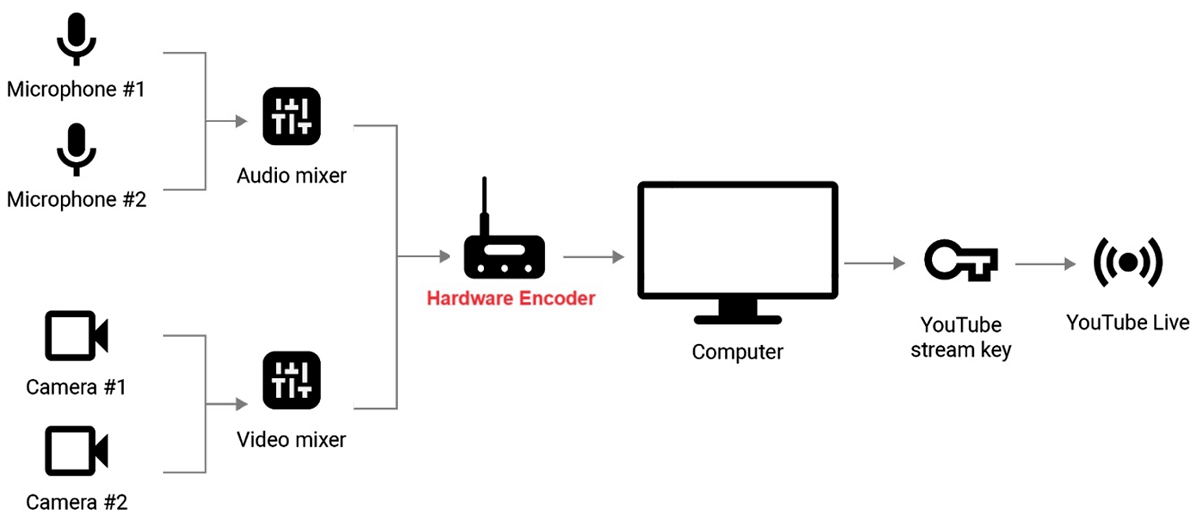
Table of Contents
1. What is a live video encoder?
2. Do I need an encoder for live streaming?
Reason3: Support specific codes and multi protocols
Do I Need an Encoder to Livestream on YouTube?
3. What encoder is good for streaming?
4. How do I stream live using an encoder?
A live video encoder is a crucial component in the live streaming process, responsible for converting raw video feeds into a format suitable for online streaming. The encoder compresses the video data, reducing its file size while maintaining the highest possible quality. This allows for smooth and efficient streaming over the internet.
There are two types of live video encoders: software encoders and hardware encoders.
They are programs installed on a computer, which use the device's processing power to convert the video feed. While they are more accessible and cost-effective than hardware encoders, software encoders can be resource-intensive and depend on the computer's CPU and GPU capacities.
In contrast, hardware encoders are standalone devices designed specifically for live video encoding. They have built-in processors optimized for video compression, resulting in higher performance and reliability than software encoders. However, hardware encoders are typically more expensive and may require additional setup.
The encoder can convert the raw video and audio data from a camera or other input source into a format suitable for streaming on platforms. This process is crucial as it allows the data to be transmitted efficiently over the internet to reach viewers without severe buffering or quality issues.
Using an encoder also provides the ability to customize the stream's quality, resolution, and bitrate according to the specific requirements of the platform and the equipment being used. This ensures optimal streaming performance and user experience, regardless of whether the viewer is using a desktop or mobile device.

Reason3: Support specific codes and multi protocols
Live streaming platforms often use specific video codecs and streaming protocols. Encoders help to transform the input video data into the platform's required format, for instance, the H.264 codec or the RTMP protocol for YouTube. By doing so, the video becomes compatible with the platform's infrastructure and can be viewed by a wide range of devices.
Some encoders offer advanced features such as adaptive bitrate streaming, a technique that dynamically adjusts the video quality in real-time based on the viewer's internet connection. This ensures a stable and smooth viewing experience, even when network conditions fluctuate.
In summary, an encoder plays a crucial role in preparing and optimizing your video content for streaming on platforms like YouTube. It ensures compatibility with target platforms, efficient transmission over the internet, and presents an enjoyable viewing experience for the audience.
Do I Need an Encoder to Livestream on YouTube?
Yes, using an encoder is necessary when live streaming on YouTube. An encoder is a software or hardware tool that compresses and converts video and audio files into a format suitable for live streaming platforms like YouTube. While live streaming, the encoder takes your video input, compresses it, and sends it to your chosen platform in real-time.
Selecting a suitable encoder for streaming depends on factors such as your budget, video quality, and the devices you'll be using. A reliable encoder should have a user-friendly interface, adapt to different bandwidths, and provide smooth, high-quality video streaming.
Hardware encoders are dedicated devices that focus solely on encoding and streaming. They often provide higher quality and better compression, especially for professional setups. Examples of popular hardware encoders include the Teradek VidiU Go, Magewell Ultra Stream HDMI, and the Blackmagic Design Web Presenter.
Software encoders are applications installed on computers or other devices. They tend to be more affordable and flexible but may require higher system resources. Some well-regarded software encoders are OBS Studio, which is open-source and free, Wirecast, a powerful option with advanced features, and vMix, which offers a competitive balance of functionality and price.
When considering an encoder, think about the following:
Aim for an encoder that supports at least 1080p resolution and h.264 encoding, as this is a widely accepted standard for quality streaming.
It can maintain long-term stable output of high-quality stream. For software encoders, their dependence on the user's computer or device for processing power. and we need to ensure that enough resources are allocated for this and not taken up by other activities on the computer.
Because the hardware encoder only completes the coding work, its stability is better.
Look for a user-friendly interface, as well as compatibility with your streaming platform and devices.
Low latency ensures quick transmission of the video stream to your audience. It is particularly important for live events and interactive streaming.
For sporting events, the portable live encoder is better and can be placed on the camera for easy moving.`
For the outdoors live, it needs support 4G and built-in batteries and is easy to move.
It's essential to research and test various encoders to find one that meets your specific requirements. Ideally, the encoder you choose should strike a balance between quality, ease of use, and affordability while providing a seamless live-streaming experience to your viewers.
To stream live using an encoder, follow these general steps:
Connect the video source (camera, capture card, etc.) to the encoder.
Configure the encoder settings according to your streaming platform's recommendations.
Obtain the stream key and server URL from the streaming platform.
Input the stream key and server URL into the encoder.

Start streaming from the encoder, and monitor the live feed on the streaming platform.